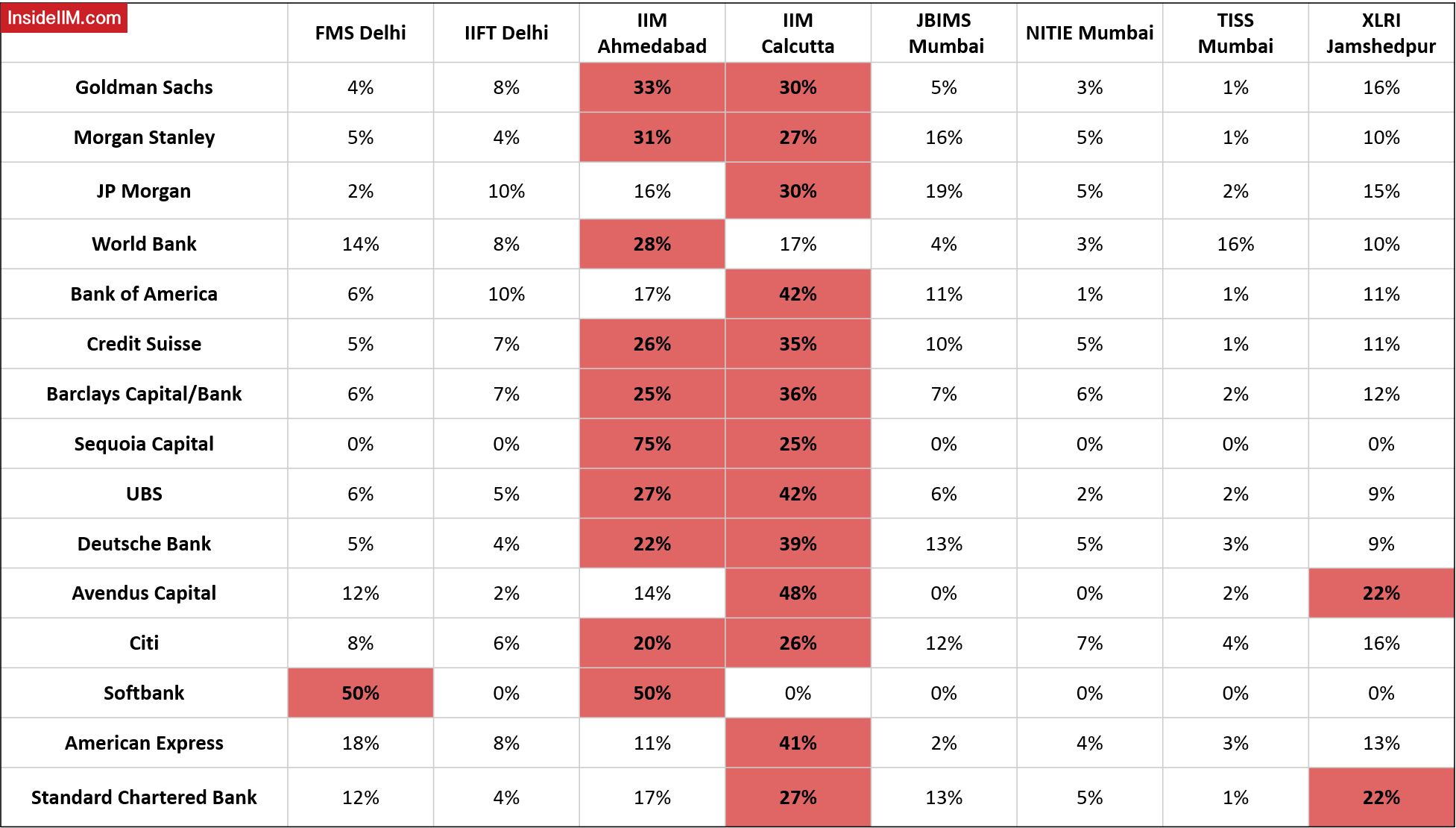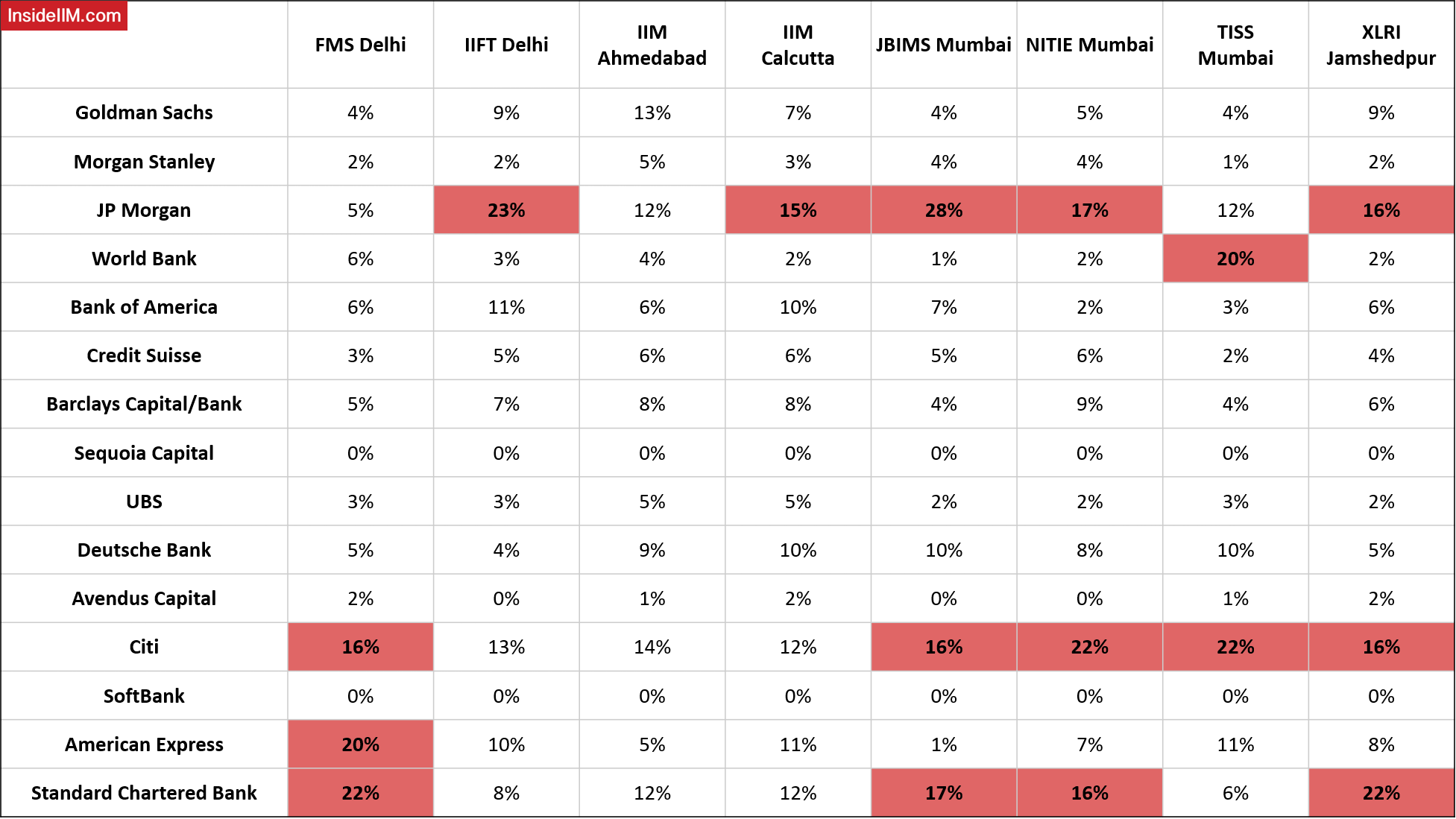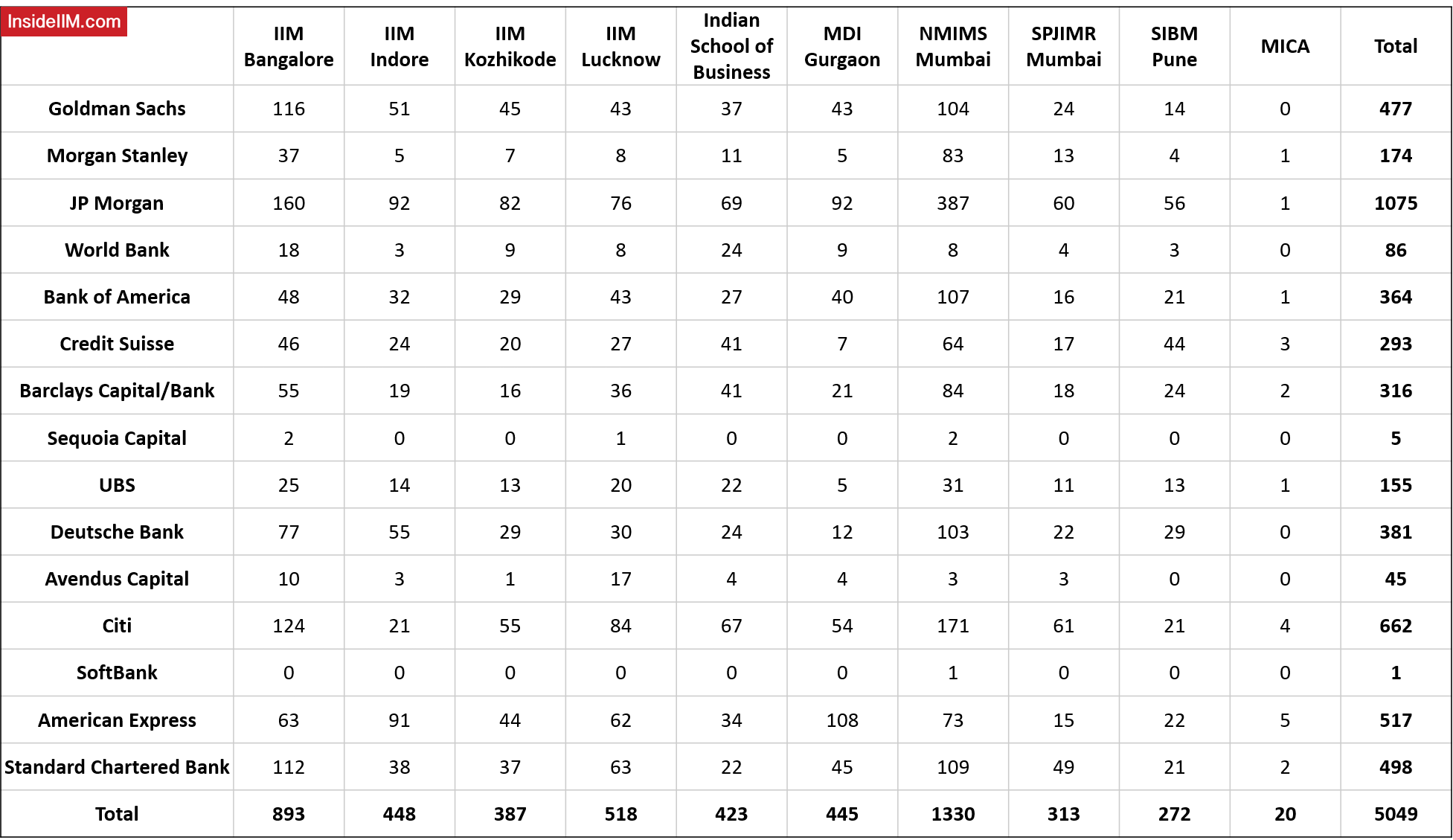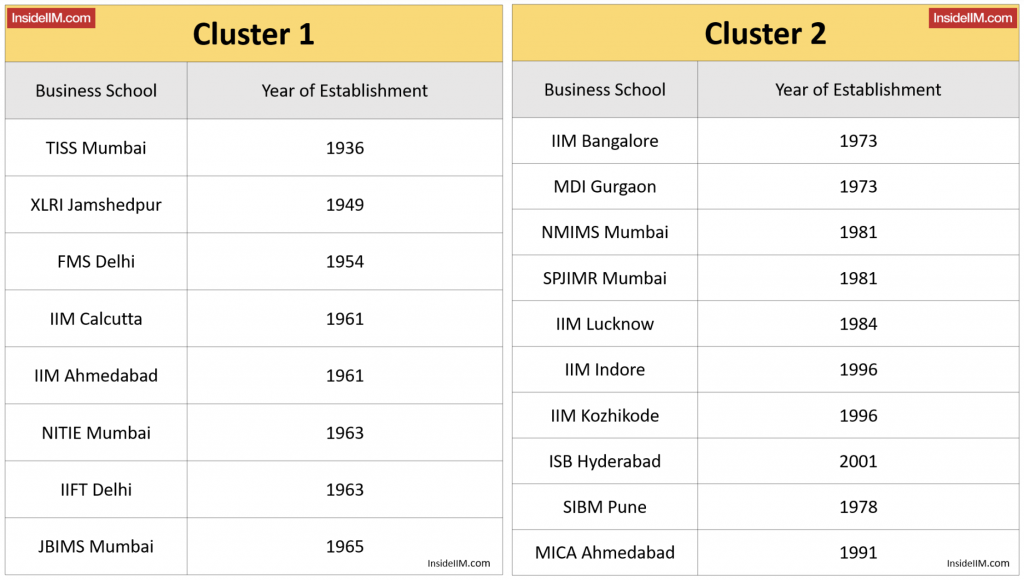For all MBA stakeholders - MBA aspirants, students and alumni - it is very interesting to track where graduates of top business schools are working today. In the Alumni Report series, we do just that. We attempt to present a rough estimate of the concentration of alumni of top B-schools across top companies in various industries. This part of the Alumni Report series will be concerned with alumni concentration across top Banking and Finance companies as per our latest Recruitment Survey reports.
What Is The InsideIIM Alumni Report? What Data Is It Based On?
The Alumni Report series, which first began in 2012, is an analysis of the concentration of alumni of top b-schools at India's most desirable companies to work with, as per MBA students and graduates. This series aims to answer the all-important question - where are MBA graduates from top b-schools working now? For current MBA students, this report aims to provide an estimate of which top companies have the highest concentration of their respective institutes' alumni.
The Alumni Reports are based on secondary research involving the collection of publicly available data on LinkedIn. Given that this method of data collection has its limitations, the data provided is best interpreted as an estimate. It is advised that the reader interpret the tables below cautiously.
What Are The Contents of This Report?
This report has been split into two clusters based on the years in which the top b-schools considered for this report were established. The rationale behind such as a selection criterion is to ensure that the alumni base is strong and comparable for the b-schools under comparison. For a more detailed explanation, please refer to the section titled 'Methodology' in this report.
The report has been further split into two sub-clusters for each of the two primary clusters. These two sub-clusters are:
- Company-wise Slicing, i.e., the percentage of alumni of all b-schools at a particular company (view row-wise).
- B-School wise Slicing, i.e., the percentage of alumni of a particular b-school at all companies (view column-wise).
Analysis For B-Schools Established Before 1966

The table above contains the raw data for Indian b-schools established before 1966. Please note the following:
- Relevant filters on roles and domains have been applied in the research process. However, the existence of anomalies is also quite possible. So, there can be a positive or negative variance from the actual figures.
- All possible businesses of the companies have been considered. For instance, numbers under ‘ITC’ consist of relevant employees at Consumer Goods, Infotech, Hotels, etc.
- In this report, a higher number does not equal more influence on alumni of specific business schools. The seniority of alumni, quality and diversity of roles play a bigger part. Unfortunately, this cannot be captured with exact accuracy given the subjectivity involved.
Company-Wise Slicing: Alumni Of Top Business Schools As A Percentage Of The Total Number Of Alumni Of Each Company

Cells for companies where %age of total alumni of a B-school ≥ 20% have been highlighted in Red.
Observations
- As has been the case ever since the inception of the Alumni Report series, IIM Calcutta dominates when it comes to the BFSI sector. With the exception of SoftBank, IIM Calcutta alumni makes up at least 1/4th of the total percentage of alumni working at any of these companies. This is not a shocking trend, given that IIM-C has gained a reputation for being India's 'Finance Campus'. Especially at companies like Avendus Capital and American Express, IIM C have a very significant presence.
- IIM Ahmedabad comes in at second position with more than 20% representation at most of the top companies. XLRI, though not crossing the 20% mark, still does have a decent representation at most of the companies mentioned in this report, with a spike at Standard Chartered and Avendus.
- When it comes to alumni representation at multi-lateral organisations such as the World Bank, the alumni of IIM Ahmedabad come out on top. The concentration of NITIE alumni is also fairly low at the companies mentioned in this report. Perhaps due to the specialized nature of the program offered, Finance companies are not as popular among NITIE alumni. IIFT and FMS Delhi alumni are also relatively underrepresented in the mentioned companies, having ~1000 alums lesser than IIM C in these companies.
School-Wise Slicing: Alumni of Top Business Schools As A Percentage Of Overall No. Of Alumni Of Respective B-Schools

Cells for B-schools where %age of alumni at a particular company ≥ 15% have been highlighted in Red.
Observations
JP Morgan, Citi and Standard Chartered emerge as big recruiters across all the campuses in this cluster. If you're from FMS Delhi, it is likely that you may land up at Citi, Amex or Standard Chartered at some point in your career. If you're from JBIMS, it would be JP Morgan, Citi and Standard Chartered. A notable observation is the concentration of TISS alumni at the World Bank and Citibank making ~45% of TISS alumni for whom data was available.
Analysis For B-Schools Established After 1966

The table above comprises the raw data for Indian business schools established post-1966. Please note the following:
- Relevant filters on roles and domains have been applied in the research process. However, the existence of anomalies is also quite possible. So, there can be a positive or negative variance from the actual figures.
- All possible businesses of the companies have been considered. For instance, numbers under ‘ITC’ consist of relevant employees at consumer goods, infotech, Hotels, etc.
- In this report, a higher number does not equal more influence on alumni of specific business schools. The seniority of alumni, quality and diversity of roles play a bigger part. Unfortunately, this cannot be captured with exact accuracy given the paucity of time and subjectivity involved.
- The figures at NMIMS Mumbai may be heavily influenced by the alumni of NMIMS who may have pursued a non-MBA undergraduate degree from NMIMS, though the filters applied during the research will minimise such anomalies.
- The data for IIM Kozhikode are to be treated with caution, given previous technical glitches resulting in incorrect mapping IIM K alumni on LinkedIn.
Company-Wise Slicing: Alumni Of Top Business Schools As A Percentage Of The Total Number Of Alumni At Each Company

Cells for companies where %age of total alumni of a B-school ≥ 20% have been highlighted in Red.
Observations
- NMIMS has a clear advantage in terms of alumni presence, though this can be attributed to the large batch size (the largest across all B-schools in this report), as well as the inclusion of undergraduate degrees.
- IIM Bangalore is the second most dominant B-school in this Cluster, with a significant alumni presence across 7 out of 15 companies in this report. Amongst IIMs in this Cluster, IIM Bangalore appears to be miles ahead of its counter-parts in terms of alumni representation.
- Alumni of SIBM Pune and MICA, relatively new entrants in the Alumni Report series, are not as well represented compared to other B-schools in this cluster, as well as the representation they enjoy when it comes to Consumer Goods companies. A significant percentage of SIBM Pune alumni are present in Credit Suisse.
- You can see a steady rise in IIM Kozhikode and IIM Indore numbers over the years with more batches and past alumni performing better. IIM Lucknow, ISB and MDI Gurgaon also have decent representation, with SPJIMR probably having lower numbers due to smaller batch size.
School-Wise Slicing: Alumni of Top Business Schools As A Percentage Of Overall No. Of Alumni Of Respective B-Schools

Cells for B-schools where %age of alumni at a particular company ≥ 15% have been highlighted in Red.
Observations
- JP Morgan emerges as the biggest recruiter of alumni for this Cluster of B-schools and that too by a mega margin. It is almost double of the number in Cluster 1.
- After JP Morgan, Amex and Citi are also significantly large recruiters when it comes to the alumni of B-schools in Cluster 2. Nearly 21% of the total number of alumni in this report are working at JP Morgan, with another 13% working at Citi.
- As with Cluster 1, there is hardly any representation at VC firms like Sequoia Capital and SoftBank.
Methodology
B-School & Company Selection
The various ‘top business schools’ in this report have been picked up from the InsideIIM MBA Rankings for 2020. The various companies in this report are the Top-15 companies from our report on the Most Desirable BFSI Companies of 2019.
Cluster-wise Segmentation
In order to ensure that the alumni base of the various business schools is comparable and not vastly different, we segmented the 18 business schools in this report into 2 clusters: Pre-1966 and Post-1966. As there was no top B-school established between 1965 and 1973, the cut-off year chosen for dividing the schools is taken to be 1965.
The following business schools have been considered for this report:

Limitations Of The Report
As mentioned at the beginning, certain limitations of the research process prevent us from arriving at conclusions with pinpoint accuracy. Two major limitations are:
- Not everyone is on LinkedIn B-school alumni may not necessarily have registered on LinkedIn, therefore not giving a comprehensive overview of the actual figures of alumni concentration at some of the world’s most well-known and reputed BFSI companies. It is also possible that those on LinkedIn may not necessarily update their profiles, thereby giving erroneous or incomplete employment data.
- Not everyone is a B-school student: Unfortunately, LinkedIn does not allow one to filter out MBA graduates from the crowd, and therefore, it is difficult to distinguish between MBA alumni and those who have pursued a certificate course, those who have pursued a short-term duration program, or summer internships at the companies mentioned in this report. Additionally, for institutes such as NMIMS Mumbai that offer multiple courses, there are chances of errors in attempting to distinguish between NMIMS alumni who have pursued undergraduate programmes, and those who have pursued a PGDM program.
How can we improve this report? Please let us know in the comments below. We look forward to your valuable feedback.
